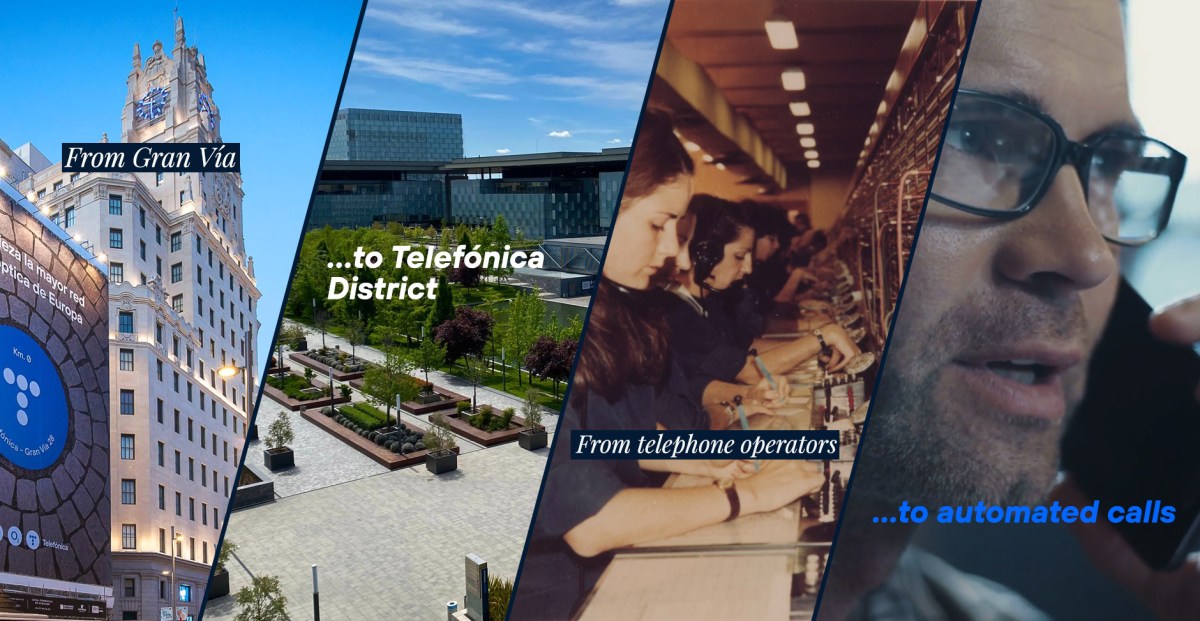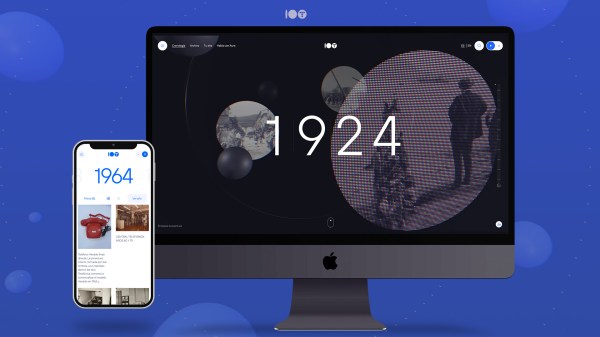In this year 2024, on 19 April to be precise, Telefónica became a centenary company. A century full of milestones and curiosities that you can explore year by year on our Centenary website, a page where the main experiences of the company’s historical evolution are collected.
We do not want to pass up the opportunity to encourage you to visit it and let yourself be carried away by browsing through it, discovering, in addition to the main events of each year -as we said before- a huge amount of audiovisual material or curiosities that happened on the planet in each and every one of the hundred years collected.
An exciting journey in which you will find some moments of special relevance for the development and construction of the Telefónica that everyone knows in this 2024.
We will review some of them in this article, reminding you that in this blog we have already published a decade-by-decade summary that we also encourage you to visit, a series that we close with a compilation post on Telefónica’s 100 years.
In this case, and unlike the decade-by-decade tour we have just mentioned, instead of compiling it in chronological order, we are going to do it in thematic blocks.
From Gran Vía to Telefónica District
Telefónica’s existence has run parallel to the history of Madrid’s Gran Vía. One of the most emblematic buildings on this iconic artery in the centre of the Spanish capital is precisely the Telefónica building, whose construction began two years after the company was founded, in 1926, and which opened its doors in 1929.
For decades it was the operator’s corporate headquarters until the move in 2008 to Distrito Telefónica, a complex of several buildings located in the north of the city of Madrid.
However, this does not mean that Telefónica has abandoned Gran Vía. Since 2012, one of the city’s cultural landmarks, the Espacio Fundación Telefónica, has been hosting numerous exhibitions and events.
Also inside the building, and since 2024, the Movistar Space is the ‘kilometre zero’ of technology and entertainment in its almost 3,000 square metres, where innovation and legacy coexist in the recently inaugurated space after a remodelling in which floors, coffered ceilings, lamps and original railings from the 20s and 30s of the last century have been recovered.
From telephone operators to automated calls
From what telephone communication is like in the 21st century to what it was like when Telefónica was born in 1924, a world has passed. One of the novelties that would be most striking to someone who was cryogenised a century ago and is now appearing would be to see that there is no longer any need for intermediaries to ‘set up’ telephone conferences.
A process of automation which, it is true, began to become popular at the beginning of the 20th century and which has a curious origin in the competition between two undertakers in Kansas City, Missouri (United States).
Why? Well, because a businessman who had recently moved to the city discovered that he was not receiving any new customers – despite the fact that there always are in this sector – and it turned out to be because the telephone operator in charge of forwarding the calls was the wife of the owner of another funeral parlour?
But back to Telefónica, the truth is that as early as 1926 the company put its first automatic exchange into operation, the inauguration of which was even attended by King Alfonso XIII in Santander, a town that was the site of the first telephone exchange.
Pero todavía quedarían seis décadas hasta que la última de las operadoras llevara a cabo su misión de conectar al emisor con el receptor de una llamada telefónica. Un evento que took place in December 1988 in the town of Polopos, Granada, where Magdalena Martín went down in the company’s history as the last of the so-called ‘cable girls’. An evolution that had advanced enormously, since in 1977 95% of Telefónica’s fixed lines were already automatic.
From the first transatlantic call to mobile telephony
Telephony has evolved enormously and Telefónica has been synonymous with this evolution for decades for many generations, especially in Spain.
Since fixed telephony was created by Antonio Meucci (despite Alexander Graham Bell) or mobile telephony by Martin Cooper, its social impact has been enormous and has been revolutionising the world at the same time as it has evolved.
Telefónica has experienced some important milestones related to what, at the time, was its main line of business.
In terms of fixed telephony, we can go back to the 1920s, specifically to 13 October 1928. On that day, King Alfonso XIII telephoned US President Calvin Coolidge from the Gran Vía building.
A historic milestone which, according to our centenary website, was the ‘first transatlantic telephone communication that used all the transmission techniques possible at the time: aerial copper wire between Madrid and Zaragoza, using the ordinary frequency of the human voice, to continue to Versailles with high frequency, and from there to Boulogne by land cable and cross the English Channel connecting with London. From Rugby in the United Kingdom, the radio voice was broadcast across the Atlantic, received on the coast of Canada and carried by cable to Washington’.
Also in the same year, the first public service telephone in Spain was installed in Madrid’s Retiro Park, in a display case in the Viena Park. Without being strictly speaking a booth (they would not arrive until decades later), it could be considered a predecessor of the almost 100,000 booths and public telephones that would populate Spain.
With regard to mobile telephony, in the 1970s it arrived in Spain thanks to Telefónica with a service for cars known as TAV (Automatic Telephone in Vehicles), a precursor system of a technology that would experience its explosion in the 1990s with the arrival of MoviLine and Movistar and the transition from the original 1G to the current 5G.
From 15 years to 2000 to fibre
Mathematics doesn’t fail: in 1985 it was 15 years to the year 2000. An emblematic Telefónica campaign anticipated how technology would evolve thanks to the development of a then almost unknown phenomenon called the Internet, which had been born shortly before.
An Internet that would see its explosion in the 1990s: from 320,000 Internet users in 1996, at the end of the century – in 1999 – it became very popular in homes and companies with the ADSL flat rate.
As a curiosity, we can add that Telefónica was the first European operator to launch this technology with various options: from a basic ADSL with download and upload speeds of 256kbps/128 kbps to a premium one with 2 Mbps/300 kbps.
From Spain to internationalisation
With its origins in Spain, from the 1990s onwards it began an internationalisation process that reached Latin America and Europe, with Argentina and Chile being the countries where this process began.
Telefónica currently has a strong presence in 12 countries: Spain, Germany, Brazil, United Kingdom, Argentina, Chile, Colombia, Ecuador, Uruguay, Venezuela, Mexico and Peru.
This process of expansion into other geographies saw two major milestones in the 2000s: in 2004 Telefónica became the leading mobile operator in Latin America and two years later the purchase of O2 was the largest operation by a Spanish company abroad.









